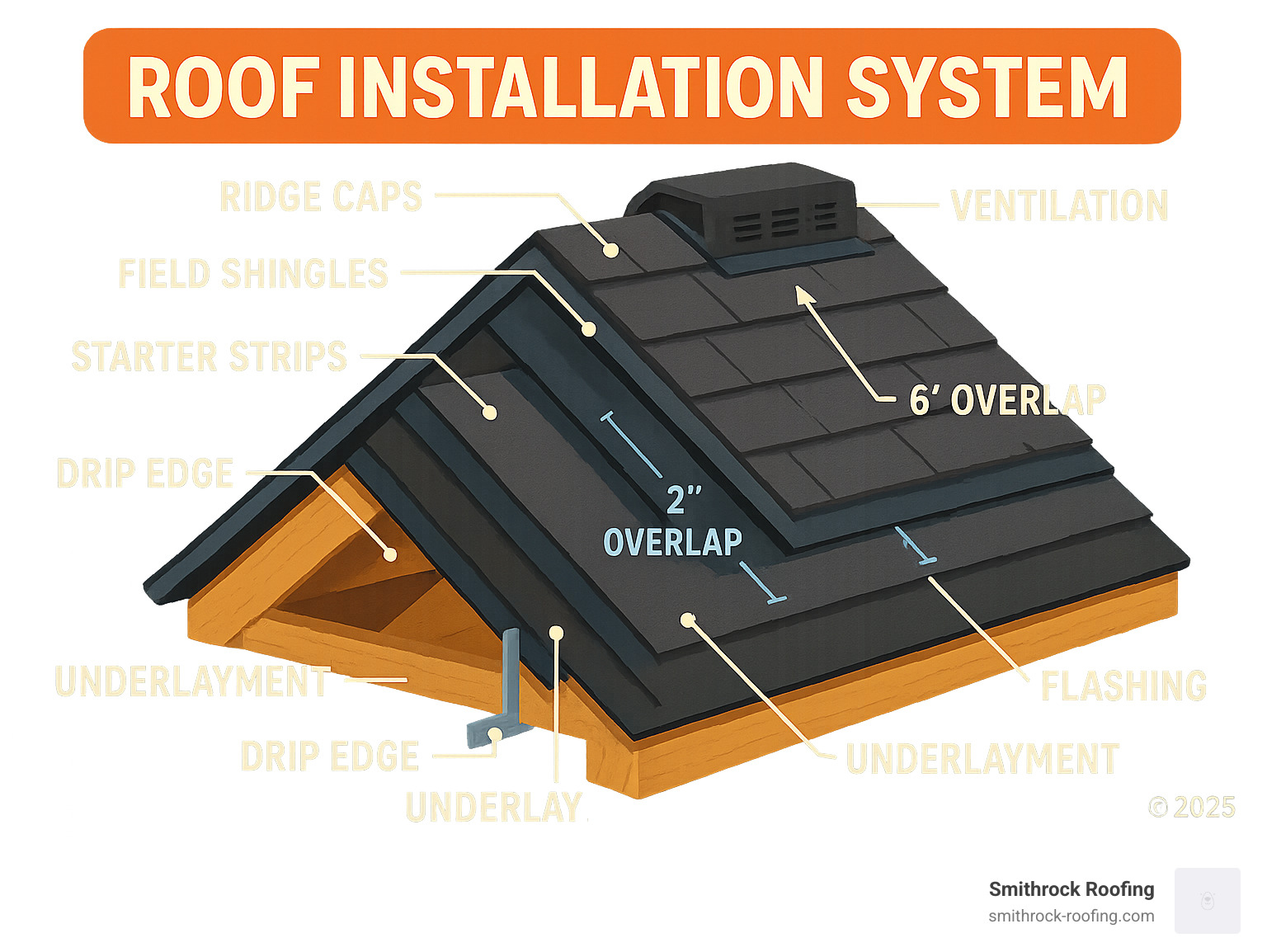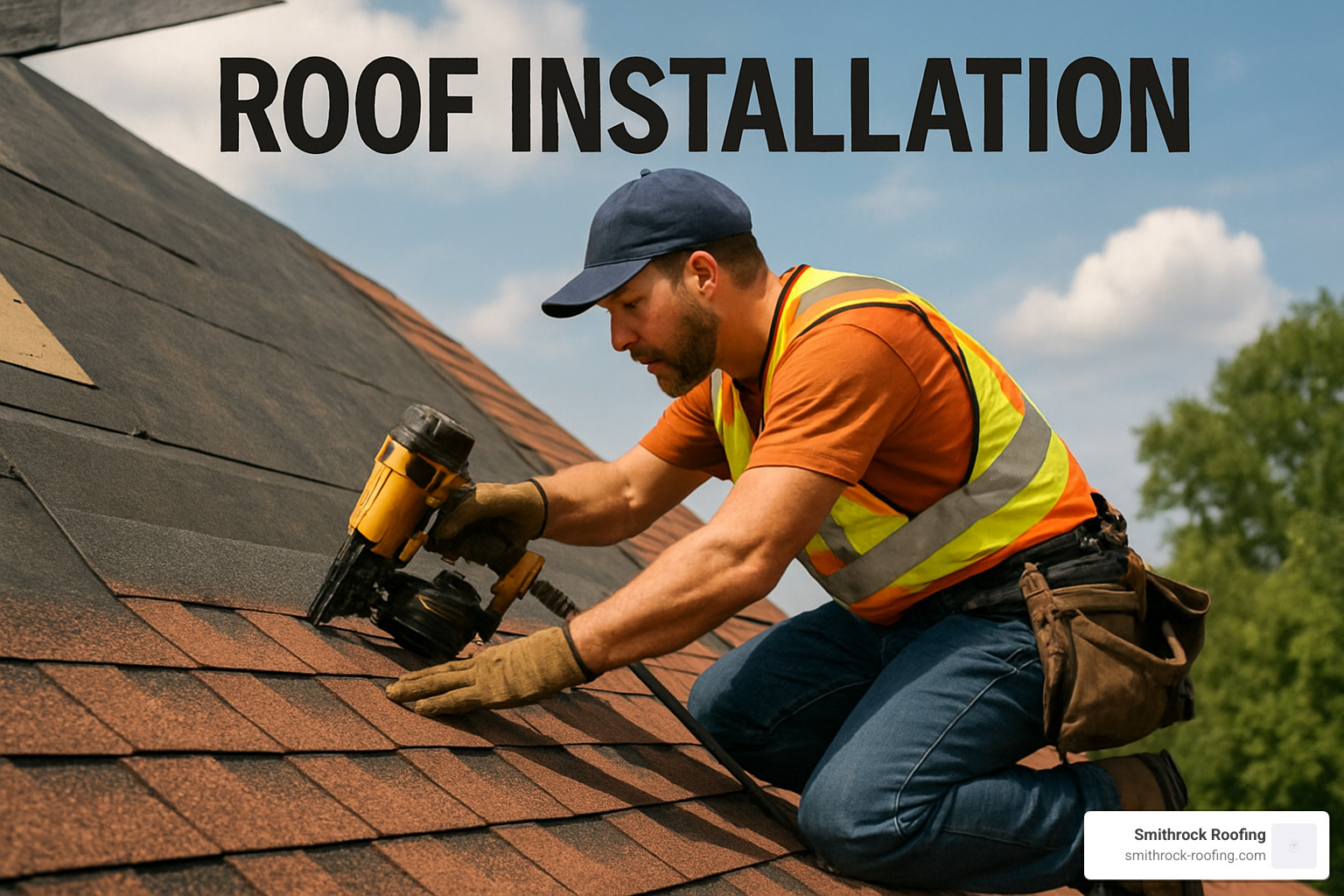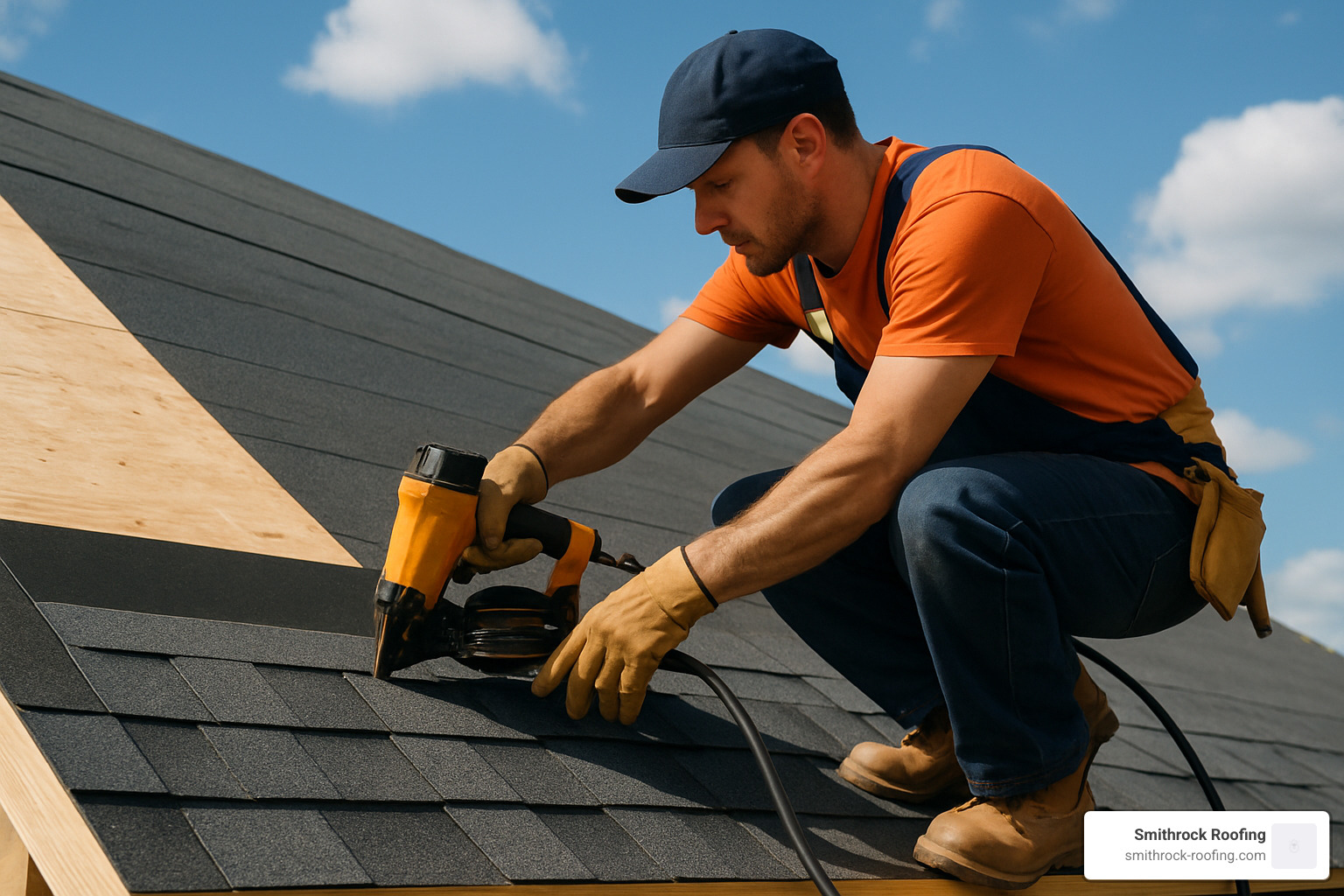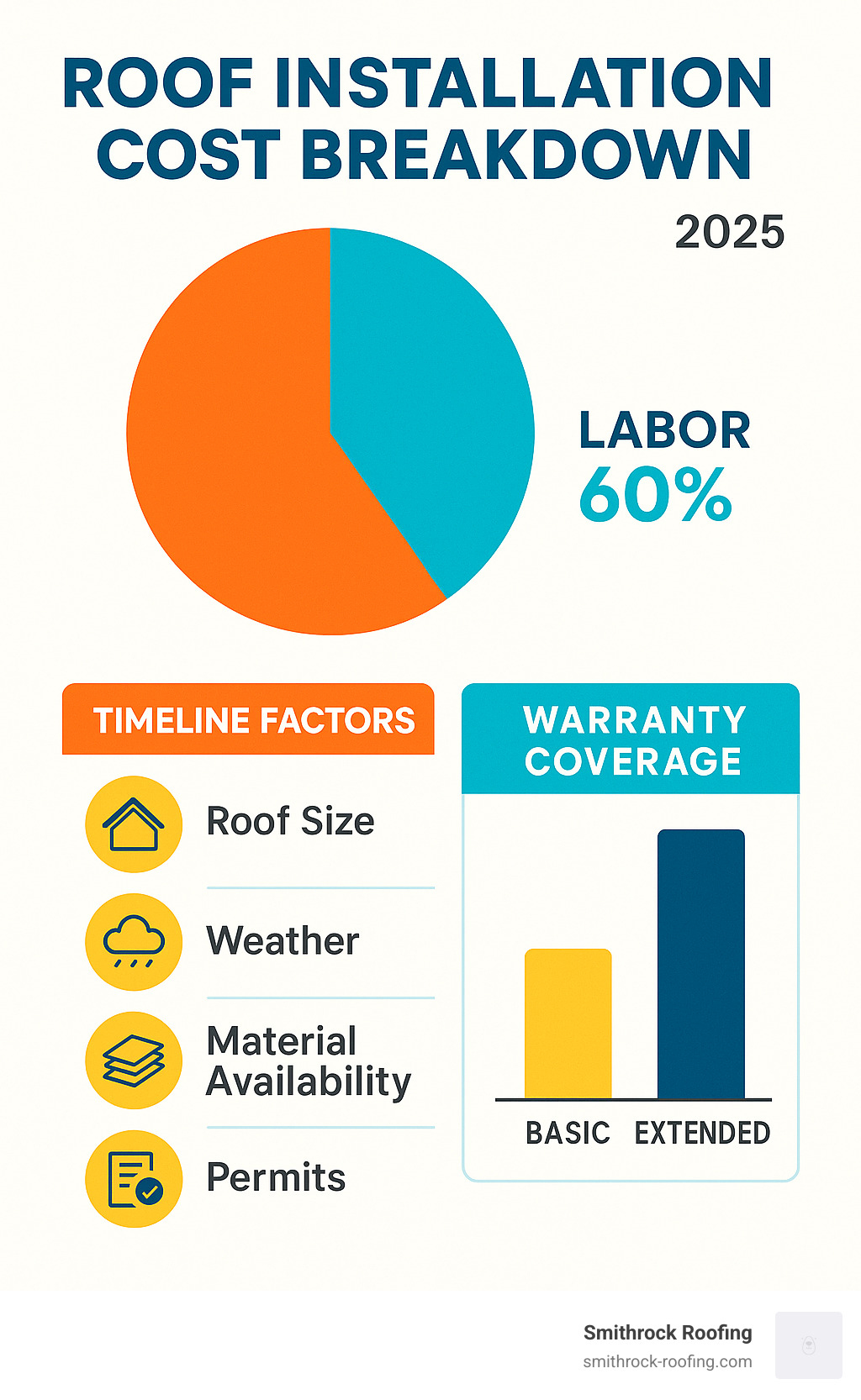Roof installation is one of the most significant investments homeowners make, with the national average cost around $8,000 and projects typically ranging from $5,500 to $11,000. When done right, a quality roof installation protects your home for decades and can return about 60% of its value when you sell.
Key factors for successful roof installation:
The complexity of modern roof systems—from ice barriers and underlayment to proper flashing and ventilation—means getting it right the first time is crucial. Poor installation can lead to premature failure, voided warranties, and costly repairs.
As one roofing expert noted: “It’s all about the layers. Build roof layers the right way and your home will stay dry inside for its entire life.”
The stakes are high when choosing a contractor. A properly installed roof protects your biggest investment, while cutting corners can result in leaks, structural damage, and safety hazards. That’s why finding trustworthy professionals who follow manufacturer guidelines and local building codes is essential.
I’m Jordan Smith, and I’ve spent over 15 years in exterior construction, helping homeowners steer roof installation decisions and identify quality workmanship.

When it comes to roof installation, the difference between a contractor you can trust and one you can’t extends far beyond price. We’ve seen too many homeowners learn this lesson the hard way—choosing the lowest bidder only to face leaks, warranty issues, and safety concerns within months.
Trustworthiness is everything in roof installation. A reliable contractor will provide detailed written estimates, explain the installation process clearly, and offer references from recent projects. They’ll also be transparent about potential challenges and how those issues affect timeline and budget.
Safety must come first. Professional roof installation involves significant fall risks, heavy materials, and power tools. Qualified contractors carry proper insurance, use fall protection equipment, and follow OSHA guidelines.
Long-term value depends on quality workmanship. A properly installed roof should last its full rated lifespan—25 years for asphalt shingles, 50-75 years for metal roofs. When contractors cut corners on installation, homeowners often face premature failure and costly repairs that could have been avoided.

Understanding the roof installation process helps homeowners make informed decisions and communicate effectively with contractors. Modern roofing systems are complex, layered assemblies where each component plays a crucial role in weather protection.
The foundation starts with proper deck preparation. During tear-off, contractors remove old shingles and inspect the roof deck for damage. Any rotted or weak sections must be replaced before installation continues.
Underlayment serves as the critical moisture barrier. Synthetic felt or ice-and-water shield goes over the deck, overlapping by at least 6 inches at seams. In cold climates, ice-and-water barrier should extend at least 24 inches inside the interior wall line.
Drip edge installation comes next. This metal flashing directs water away from the roof deck and fascia boards. Proper installation requires placing drip edge at eaves before underlayment, then over underlayment at rakes.
Flashing protects the most vulnerable areas. Valleys, chimneys, vents, and wall intersections require specialized flashing techniques with proper overlap requirements.
Material selection significantly impacts performance and longevity:
| Material | Lifespan | Cost per Square | Best For |
|---|---|---|---|
| Asphalt Shingles | 20-30 years | $100-$400 | Budget-conscious, traditional look |
| Metal Roofing | 50-75 years | $300-$1,000 | Longevity, energy efficiency |
| Cedar Shakes | 25-40 years | $400-$700 | Natural appearance, insulation |
For more detailed guidance on when repair might be sufficient versus full replacement, check out our comprehensive guide on roof repair vs replacement.
Professional roof installation follows a precise sequence that ensures optimal weather protection and longevity.
1. Complete tear-off and disposal. Remove all old roofing materials down to the deck for proper inspection and material bonding.
2. Deck inspection and repairs. Check for rot, loose fasteners, or structural issues. Replace damaged sections and ensure the deck is smooth and properly secured.
3. Install drip edge at eaves. Attach metal drip edge along the eaves using roofing nails spaced every 12 inches.
4. Apply ice-and-water barrier. In cold climates, install self-adhering membrane at eaves, extending at least 24 inches inside the wall line.
5. Install underlayment. Roll out synthetic felt across the entire roof deck with proper overlap specifications.
6. Install drip edge at rakes. Place drip edge over the underlayment at rake edges for proper water flow.
7. Flash valleys and penetrations. Install valley flashing before shingles, using proper overlap techniques.
8. Install starter course. Place starter shingles along eaves and rakes to provide foundation for field shingles.
9. Install field shingles. Begin at the bottom and work upward, maintaining proper exposure and staggering joints.
10. Install ridge caps and final details. Cap all ridges and hips, seal exposed nail heads, and complete cleanup.
Professional roof installation requires specialized tools and high-quality materials. Critical tools include roof shovels, coil nailers, chalk lines, and safety equipment. Essential materials include hot-dipped galvanized nails, ice-and-water shield, synthetic felt underlayment, and proper flashing materials.
For detailed specifications, contractors often reference resources like AutoCAD roof files to ensure proper installation techniques.

Choosing the right contractor makes or breaks your roof installation project. I’ve seen too many homeowners learn this lesson the hard way—picking a contractor based solely on price, only to face leaks, warranty disputes, and abandoned projects within months.
Start with the basics: proper licensing and insurance. Any contractor you’re considering should carry a current license and registration in your state. They also need general liability insurance of at least $2 million and workers’ compensation coverage. Ask to see certificates and verify they’re current.
Look for manufacturer certifications. GAF certification means the contractor has received proper training on installation techniques and stands behind their work. These certifications represent ongoing education and commitment to quality workmanship.
Check their local reputation thoroughly. A contractor’s Better Business Bureau rating tells you how they handle complaints. Ask for references from recent projects in your area. Quality contractors are proud of their work and happy to share contact information for satisfied customers.
Pay attention to communication style. Professional contractors explain the roof installation process clearly without using high-pressure sales tactics. They provide detailed written estimates, respond promptly to questions, and walk you through material options and timeline expectations.
Review their project portfolio carefully. Ask to see photos of recent installations similar to your home. Pay special attention to detail work around chimneys, valleys, and other complex areas.
Ask the right questions upfront. How long have they been installing roofs in your area? Can they provide references from recent projects? What happens if weather delays the project? How do they handle unexpected repairs? Will they pull necessary permits?
For more information about our comprehensive warranty coverage, visit our warranty page.
Recognizing poor installation practices can save you thousands in future repairs. Over the years, I’ve been called to fix countless botched installations, and the problems usually stem from contractors who cut corners or lack proper training.
Improper nail placement is the most common issue we encounter. Nails driven too high, too low, or at an angle compromise wind resistance and void manufacturer warranties. Professional installers know the exact placement requirements for each type of shingle.
Missing or improperly installed drip edge leads to fascia rot and water infiltration. Some contractors skip this step entirely to save time and money, but it’s required by most building codes.
Buckled or wrinkled underlayment creates uneven surfaces that telegraph through shingles and compromise weather protection. Professional installers take time to keep underlayment smooth and properly fastened.
Inadequate ventilation causes premature shingle failure and ice dam problems. Proper ventilation requires balanced intake and exhaust, typically achieved through soffit vents and ridge vents.
Comparing roof installation quotes requires careful attention to details beyond the bottom-line price. Quotes can vary significantly for seemingly identical projects—and the cheapest option often costs more in the long run.
Scope of work variations make huge differences in final costs. Some contractors include complete tear-off in their base price, while others price it separately. Always ask for detailed line-item breakdowns.
Material specifications affect quality and longevity dramatically. Generic “architectural shingles” could mean anything from basic 20-year products to premium 50-year materials. Insist on specific brand names and model numbers for accurate comparison.
Warranty terms vary significantly between contractors. Understanding warranty differences helps you evaluate the true value of each proposal.
Let’s talk money—because when it comes to roof installation, understanding the financial picture helps you make smart decisions without any unwelcome surprises.
Labor makes up about 60% of your total roof installation cost, while materials account for the remaining 40%. This means the skill and experience of your installation crew directly impacts the value you receive.
Regional pricing varies based on material availability and local building codes. When storm season hits and everyone suddenly needs a new roof, prices can temporarily spike due to high contractor demand.
Quality roof installation doesn’t have to break the bank. Many homeowners find that financing options make it easier to invest in proper installation rather than cutting corners. For detailed information about making your project more affordable, check out our guide on lifting your roofing experience with finance options.
Your installation timeline depends on several moving parts. Roof size and complexity play obvious roles, but weather conditions often become the biggest factor. Material availability can also impact scheduling, and any surprise deck repairs found during tear-off can extend timelines.
For comprehensive cost information beyond our local market, Forbes provides detailed analysis of national average roof replacement costs that can help you understand broader pricing trends.

When homeowners ask us about roof installation costs, we always start with material selection because that’s where you have the most control over your budget.
Asphalt shingles run $100-$400 per square and remain the most popular choice. They’re available in everything from basic 3-tab styles to premium architectural designs. With proper installation, you’ll get 20-30 years of reliable performance.
Metal roofing costs $300-$1,000 per square but offers a lifespan of 50-75 years. The upfront investment is higher, but when you factor in energy savings and longevity, the math often works out favorably for long-term homeowners.
Cedar shakes fall in the $400-$700 per square range and bring natural beauty with excellent insulation properties. They require skilled installation and regular maintenance to reach their 25-40 year potential lifespan.
Beyond materials, don’t forget additional costs: permit fees typically run $100-$500, disposal costs add $300-$800, and deck repairs can range from $2-$10 per square foot depending on damage extent.
Professional roof installation typically takes 1-3 days for standard residential projects under 3,000 square feet.
Tear-off usually takes 4-8 hours depending on the number of old shingle layers, roof complexity, and access challenges. This phase creates the most dramatic change to your home’s appearance but is necessary for quality results.
Deck repairs add time but provide essential value. Minor repairs might add just a few hours, while extensive structural work could extend your project by several days.
Shingle installation pace depends on crew size and experience. Professional crews typically install 15-20 squares per day in good conditions. Complex roofs with multiple valleys, dormers, or chimneys require more time for proper detail work.
Weather delays are part of the process. Rain, high winds, or extreme temperatures can halt work entirely. Quality contractors won’t compromise safety or installation quality to meet arbitrary deadlines.
Final inspection and cleanup typically take 2-4 hours, including checking all flashing, sealing exposed nails, and thorough site cleanup with magnetic sweeping.
When it comes to roof installation, safety isn’t just important—it’s literally a matter of life and death. Most roofing accidents can be avoided with proper planning and equipment.
Fall protection should never be optional. Professional contractors invest in quality harnesses, safety ropes, and fall arrest systems. OSHA requires fall protection for any work above 6 feet, but experienced roofers often exceed these minimum standards.
Proper ladder setup is where many accidents begin. Your ladder needs to extend at least 3 feet above the roofline and be properly secured. A common mistake is stepping on ladder rungs above the roofline instead of stepping directly onto the roof.
Weather windows require patience and good judgment. Roof installation should only happen in dry conditions with minimal wind. Temperature matters too—shingles become brittle in cold weather, while extreme heat makes them too soft to walk on safely.
Code compliance protects everyone involved. Professional contractors pull permits and schedule inspections because building codes exist to protect homeowners and workers alike.
If you’re dealing with storm damage, timing becomes critical. Our guide on storm damage roof repair in Winston-Salem explains how to handle emergency situations while maintaining safety standards.
The National Safety Council has published research on fall prevention on standing seam metal roofs that provides insights into specialized safety techniques.
The DIY versus professional debate comes up frequently. After fifteen years in this business, we’ve learned that some savings just aren’t worth the risk.
The skill level required for proper roof installation is substantial. Modern roofing systems involve complex building codes, material specifications, and flashing techniques that take years to master. One mistake with flashing can lead to thousands in water damage.
Safety risks make DIY roofing particularly dangerous. We’re talking about heights, heavy materials, power tools, and weather exposure combined. Professional contractors have extensive training, experience, and proper safety equipment.
Warranty considerations can be costly. Many shingle manufacturers require professional installation by certified contractors to honor warranties. Choose DIY, and you might void these warranties entirely.
Resale value typically favors professional installation. Professional work signals quality maintenance to potential buyers, while DIY work often raises questions.
Proper maintenance extends roof life and protects your investment, and it’s easier than most homeowners think.
Annual inspections are your best defense. Walk around your home twice yearly looking for missing or damaged shingles, clogged gutters, and signs of water damage. Professional inspections every 3-5 years provide more thorough evaluation.
Gutter cleaning prevents expensive water damage. Clean gutters at least twice yearly, more often if you have lots of trees nearby.
Sealant checks around penetrations prevent minor issues from becoming major problems. Check sealant around vents and chimneys every few years for cracks or gaps.
Storm aftermath inspections help catch damage quickly. After severe weather, walk around your property and document any concerning damage for insurance purposes.
Age is often the biggest clue. When asphalt shingles hit the 20-25 year mark, you’ll start seeing granules washing away, leaving bare spots that look like bald patches on your roof.
Widespread damage across your roof means replacement makes more financial sense. If repairs would cover more than 30% of your roof area, or you’re dealing with multiple leaks in different spots, it’s time for full roof installation.
Structural red flags can’t be ignored. Sagging roof lines, soft spots when walking on the roof, or rotted decking are serious safety concerns that require complete replacement.
One roofing square equals 100 square feet of roof area—industry shorthand for large roof calculations.
The basic math is straightforward. Measure each roof section’s length and width, multiply together for square footage, then divide by 100. A 40×30 foot roof equals 1,200 square feet, or 12 squares.
Always add 10-15% extra material for waste and cutting. Complex roofs with valleys, dormers, or angles need more waste allowance.
The sweet spot for roof installation is dry weather with temperatures between 50-80°F. When conditions are right, materials bond properly and contractors can work safely.
Winter installation comes with real challenges. Cold temperatures make shingles brittle and harder to work with. Snow and ice create safety hazards, and some sealants need warm temperatures to cure properly.
Rainy seasons require patience. Installation must stop completely when raining, and surfaces need time to dry thoroughly before work resumes.
Your home deserves the protection that only quality roof installation can provide. After 15 years in this industry, I’ve seen how the right installation transforms not just a house, but a family’s sense of security. When storms roll through Winston-Salem, you want to sleep peacefully knowing your roof was installed by professionals who care about their craft.
The numbers speak for themselves. A properly installed roof returns about 60% of its value at resale, but the real payoff comes from decades of reliable protection. You’ll save money on energy bills, avoid costly emergency repairs, and enjoy the peace of mind that comes with knowing your family is safe and dry.
At Smithrock Roofing, we’ve made *roof installation our specialty* because we understand what’s at stake. Your home is likely your largest investment, and we treat it with the respect it deserves. From the initial consultation to the final cleanup, our team brings the expertise and attention to detail that separates quality work from quick fixes.
The difference between a good installation and a great one often comes down to the small details—proper flashing around that tricky chimney, taking time to ensure every nail is placed correctly, and using the right materials even when nobody would notice. These details matter because they determine whether your roof lasts 20 years or 30 years.
Starting your roof installation project doesn’t have to feel overwhelming. We’ll walk you through every step, explain your options in plain English, and provide the kind of detailed estimates that help you make confident decisions. No high-pressure sales tactics, no confusing technical jargon—just honest advice from people who’ve been doing this work for years.
Your next step is simple: reach out for a comprehensive evaluation of your roofing needs. We’ll assess your current roof, discuss your goals and budget, and create a plan that makes sense for your family. Whether you’re dealing with storm damage, planning ahead for an aging roof, or simply want to upgrade to better materials, we’re here to help.
Don’t wait until small problems become big headaches. Quality roof installation is an investment in your family’s future, and choosing the right contractor makes all the difference. Let us show you why homeowners throughout Winston-Salem, King, Clemmons, and Lewisville trust us with their most important home improvement projects.
For more information about our comprehensive roofing services, visit our roofing page to learn how we can help with your next project.

Smithrock Roofing © Copyright 2025 • All Rights Reserved • Privacy Policy • Maintained by Mongoose Digital Marketing